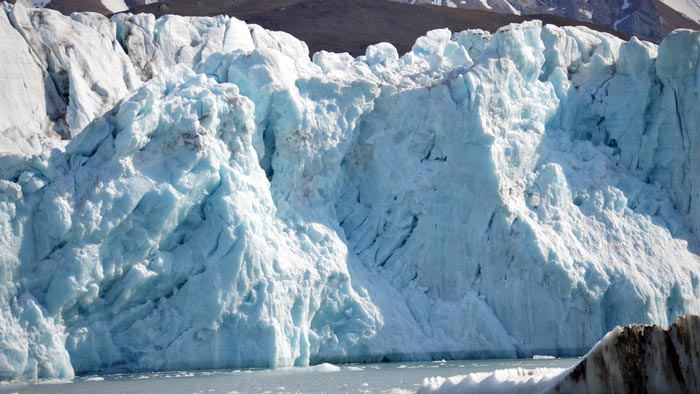Air bubbles sound climate change’s impact on glaciers #ASA181

As the world's temperatures rise, tidewater glaciers are receding and melting, releasing air trapped in the ice. Scientists can listen to the release of the air and potentially use the sounds to help them gauge the impact of climate change on the ice floes.
Credit: Johnson, Vishnu, and Deane
Melting causes accelerated ice loss at tidewater glaciers, releasing pressurized bubbles.
As the world’s temperatures rise, tidewater glaciers are receding and melting, releasing air trapped in the ice. Scientists can listen to the release of the air and potentially use the sounds to help them gauge the impact of climate change on the ice floes.
During the 181st Meeting of the Acoustical Society of America, which will be held Nov. 29-Dec. 3, Hayden Johnson, from the University of California, San Diego, will discuss how sound can be used to estimate glacial melting induced by climate change. The talk, “Spatial variation in acoustic field due to submarine melting in glacial bays,” will take place Friday, Dec. 3, at 11:45 a.m. Eastern U.S. at the Hyatt Regency Seattle.
Hari Vishnu, from the National University of Singapore, Grant Deane, from the Scripps Institute of Oceanography, and their research team investigated glacial ice melting that releases acoustically distinct pressurized underwater bubbles.
Air trapped with ice below the glacier surface becomes a compressed bubble-ice mixture that builds pressure during the long passage to the glacier terminus. The glacier ice holds ancient bubbles of air that can be up to 20 atmospheres of pressure and generate detectable sounds when they are released as the ice melts.
“We observed that the intensity of the sound generated by a melting terminus tends to increase as the water temperature increases,” said Deane. “This makes sense, because we expect the terminus to melt faster in warmer water, releasing bubbles more rapidly into the ocean and generating more sound.”
The team found as the recording array was moved further from the glacier, the variation in the acoustic melting did not follow a uniform trend.
Moreover, the acoustic intensities at different glaciers clustered in different levels. These observations indicate that the geometry of the glacier-ocean interface, the temperature and salt composition of the underwater sound channels, and the presence of floating ice impact the recorded acoustic measurements.
Their experiments will permit the monitoring of climate change’s impact on glaciers.
“Recording the underwater sounds from a melting terminus will open the door to long-term acoustical monitoring of ice loss, and how it is linked to water temperature,” said Deane. “The endgame here is to establish long-term recording stations for underwater sound around glaciers such as those in Greenland and Svalbard, to monitor their stability over time.”
– MORE MEETING INFORMATION –
USEFUL LINKS
Main meeting website: https://acousticalsociety.org/asa-meetings/
Technical program: https://eventpilotadmin.com/web/planner.php?id=ASAFALL21
Press Room: http://acoustics.org/world-wide-press-room/
Follow conference highlights with social media hashtag #ASA181
WORLDWIDE PRESS ROOM
In the coming weeks, ASA’s Worldwide Press Room will be updated with additional tips on dozens of newsworthy stories and with lay language papers, which are 300-500 word summaries of presentations written by scientists for a general audience and accompanied by photos, audio, and video. You can visit the site during the meeting at http://acoustics.org/world-wide-press-room/.
PRESS REGISTRATION
We will grant free registration to credentialed journalists and professional freelance journalists. If you are a reporter and would like to attend, contact the AIP Media Line at 301-209-3090. For urgent requests, staff at media@aip.org can also help with setting up interviews and obtaining images, sound clips or background information.
VIRTUAL MEDIA BRIEFINGS
Press briefings will be held virtually during the conference. Credentialed media can register in advance by emailing media@aip.org and include your full name and affiliation in the message. The official schedule will be announced as soon as it is available and registered attendees will be provided login information via email.
ABOUT THE ACOUSTICAL SOCIETY OF AMERICA
The Acoustical Society of America (ASA) is the premier international scientific society in acoustics devoted to the science and technology of sound. Its 7,000 members worldwide represent a broad spectrum of the study of acoustics. ASA publications include The Journal of the Acoustical Society of America (the world’s leading journal on acoustics), Acoustics Today magazine, books, and standards on acoustics. The society also holds two major scientific meetings each year. For more information about ASA, visit our website at http://www.acousticalsociety.org.
Media Contact
Larry Frum
American Institute of Physics
media@aip.org
Office: 301-209-3090
All latest news from the category: Ecology, The Environment and Conservation
This complex theme deals primarily with interactions between organisms and the environmental factors that impact them, but to a greater extent between individual inanimate environmental factors.
innovations-report offers informative reports and articles on topics such as climate protection, landscape conservation, ecological systems, wildlife and nature parks and ecosystem efficiency and balance.
Newest articles

Superradiant atoms could push the boundaries of how precisely time can be measured
Superradiant atoms can help us measure time more precisely than ever. In a new study, researchers from the University of Copenhagen present a new method for measuring the time interval,…

Ion thermoelectric conversion devices for near room temperature
The electrode sheet of the thermoelectric device consists of ionic hydrogel, which is sandwiched between the electrodes to form, and the Prussian blue on the electrode undergoes a redox reaction…

Zap Energy achieves 37-million-degree temperatures in a compact device
New publication reports record electron temperatures for a small-scale, sheared-flow-stabilized Z-pinch fusion device. In the nine decades since humans first produced fusion reactions, only a few fusion technologies have demonstrated…





















